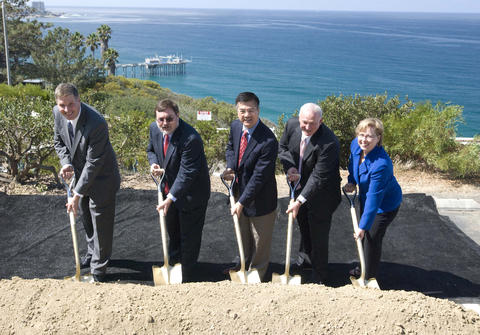U.S. Commerce Secretary Gary Locke Breaks Ground on Major San Diego-Area Recovery Act Project
$100 Million in Recovery Act Dollars to Go toward State-of-the-Art Facility on Scripps Oceanography Campus to Create Local Jobs

Groundbreaking at the Scripps Oceanography campus in La Jolla, California. From Left to Right: Patrick Gallagher, Deputy Director, NIST; Tony Haymet, Director, Scripps Institution of Oceanography; Gary Locke, Secretary, US Dept. of Commerce; Jerry Sanders, Mayor, San Diego; Margaret Spring, Chief of Staff, NOAA.
LA JOLLA, CALIFORNIA—U.S. Secretary of Commerce Gary Locke and Mayor Jerry Sanders led a groundbreaking ceremony in La Jolla, Calif., today for two new buildings dedicated to ocean science on the campus of Scripps Institution of Oceanography at UC San Diego. The project is a major groundbreaking in California under the American Recovery and Reinvestment Act (ARRA). The buildings are supported by two federal agencies—the National Oceanic and Atmospheric Administration (NOAA) and the National Institute of Standards and Technology (NIST)—and will feature state-of-the-art marine life tanks and cutting-edge science labs. Scripps Director Tony Haymet and NIST Deputy Director Patrick Gallagher were also on hand for the event.
"Today we break ground on not one, but two state-of-the-art facilities dedicated to furthering our knowledge of oceans and marine life," Locke said. "This investment will help create and support jobs and add to our storehouse of knowledge about climate and our marine environment."
Over $100 million in funding from the Recovery Act advanced construction plans for the first building, a world-class NOAA facility. The Recovery Act funds going to NOAA support the largest stimulus construction project in the San Diego area for the Commerce Department and will contribute to the creation of local construction jobs. NIST awarded $12 million to Scripps toward the construction of the second building, a new laboratory for research on marine ecosystem forecasting.
NOAA—Southwest Fisheries Science Center:
NOAA's new research facility will replace the existing Southwest Fisheries Science Center, which was partially vacated in the summer of 2008 due to continued bluff erosion. When completed, the new 120,000-square foot facility will house up to 300 staff members in laboratory, office and support space.
The new building will incorporate a large sea- and fresh-water Ocean Technology Development Tank, which will expand NOAA's ability to develop and apply advanced technologies for surveys of fisheries resources and their associated ecosystems. This world-class facility will foster collaborations on fisheries management issues and will be a focal point for surveys and assessments of species, the development and application of ecosystem-based approaches to management, research on the impacts of environmental variability, and climate change on marine ecosystems and fisheries and conservation socio-economics. Construction of the new facility is scheduled to begin in October 2010 and be completed by October 2011.
NIST—Marine Ecosystem Sensing, Observation, and Modeling (MESOM) Laboratory:
Scripps has been awarded $12 million by NIST toward construction of a new $26 million laboratory building on its campus for research on marine ecosystem forecasting. The MESOM Laboratory will enable Scripps to consolidate researchers from a variety of disciplines—who otherwise would be split among five or more different buildings—in a single dedicated facility to promote more productive discussions and interactions.
This new building will become a resource for marine ecological research at Scripps and for other national and international ocean science organizations that address the management of marine resources.The new facility will enable Scripps scientists to build upon a long history of successful research on marine ecosystems and their response to climate variability and change and to develop a new program that will provide the scientific foundation for marine ecosystem forecasting. The MESOM research program is closely tied to NOAA's work, and the results of the research and modeling will benefit collaborations with NOAA's growing program in marine ecosystem management. Construction of the new facility is scheduled to begin in early 2011 and be completed by late 2012.

